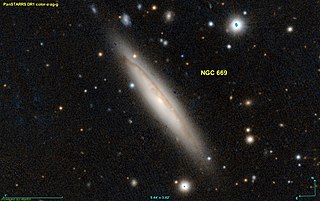
The Whirlpool Galaxy, also known as Messier 51a (M51a) or NGC 5194, is an interacting grand-design spiral galaxy with a Seyfert 2 active galactic nucleus. It lies in the constellation Canes Venatici, and was the first galaxy to be classified as a spiral galaxy. It is 7.22 megaparsecs away and 23.58 kiloparsecs (76,900 ly) in diameter.

NGC 5866 is a lenticular galaxy in the constellation Draco. NGC 5866 was most likely discovered by Pierre Méchain or Charles Messier in 1781, and independently found by William Herschel in 1788. Measured orbital velocities of its globular cluster system imply that dark matter makes up only 34%±45% of the mass within 5 effective radii, a notable paucity.

The Leo Triplet is a small group of galaxies about 35 million light-years away in the constellation Leo. This galaxy group consists of the spiral galaxies M65, M66, and NGC 3628.

The M101 Group is a loose group of galaxies located in the constellation Ursa Major. The group is named after the brightest galaxy in the group, the Pinwheel Galaxy (M101). Most of the other members of the group are companions of the Pinwheel Galaxy. The group itself is one of many located within the Virgo Supercluster.

The NGC 4038 Group is a group of galaxies in the constellations Corvus and Crater. The group may contain between 13 and 27 galaxies. The group's best known galaxies are the Antennae Galaxies, a well-known interacting pair of galaxies.

NGC 4027 is a barred spiral galaxy approximately 83 million light-years away in the constellation Corvus. It is also a peculiar galaxy because one of its spiral arms goes out more than the other. This is probably due to a galactic collision in NGC 4027's past.
The M74 Group is a small group of galaxies in the constellation Pisces. The face-on spiral galaxy M74 is the brightest galaxy within the group. Other members include the peculiar spiral galaxy NGC 660 and several smaller irregular galaxies . The M74 Group is one of many galaxy groups that lie within the Virgo Supercluster.

The M109 Group is a group of galaxies about 55 million light-years away in the constellation Ursa Major. The group is named after the brightest galaxy within the group, the spiral galaxy M109.

The NGC 4631 Group is a poorly defined group of galaxies, about 25 million light-years from Earth in the Coma Berenices and Canes Venatici constellations.

NGC 3953 is a barred spiral galaxy located in the constellation Ursa Major. It was discovered by Pierre Méchain on 12 March 1781. The galaxy is known to exhibit an inner ring structure that encircles the bar. NGC 3953 is a member of the M109 Group, a large group of galaxies located within the constellation Ursa Major that may contain over 50 galaxies.

NGC 3384 is an elliptical galaxy in the constellation Leo. The galaxy was discovered by William Herschel in 1784 as part of the Herschel 400 Catalogue. The high age of the stars in the central region of NGC 3384 was confirmed after analysis of their color. More than 80% were found to be Population II stars which are over a billion years old. The supermassive black hole at the core has a mass of 1.6+0.1
−0.2×107 M☉.

The NGC 5866 Group is a small group of galaxies located in the constellation Draco. The group is named after NGC 5866, the galaxy with the highest apparent magnitude in the group, although some galaxy group catalogs list NGC 5907 as the brightest member.

The M96 Group is a group of galaxies in the constellation Leo. This group contains between 8 and 24 galaxies, including three Messier objects. It also contains the Leo Ring. The group is one of many groups that lies within the Virgo Supercluster.

The Coma I Group is a group of galaxies located about 14.5 Mpc (47.3 Mly) away in the constellation Coma Berenices. The brightest member of the group is NGC 4725. The Coma I Group is rich in spiral galaxies while containing few elliptical and lenticular galaxies. Coma I lies in the foreground of the more distant Coma and Leo clusters and is located within the Virgo Supercluster.

NGC 3981 is an unbarred spiral galaxy located 65 million light-years away in the constellation of Crater. It was discovered on February 7, 1785, by William Herschel.

NGC 668 is a spiral galaxy located 200 million light-years away in the constellation Andromeda. It was discovered by astronomer Édouard Stephan on December 4, 1880 and is a member of Abell 262.

NGC 669 is an edge-on spiral galaxy with an active galactic nucleus located 200 million light-years away in the constellation Triangulum. NGC 669 was discovered by astronomer Édouard Stephan on November 28, 1883 and is a member of Abell 262.

NGC 679 is an elliptical or a lenticular galaxy located 210 million light-years away in the constellation Andromeda. The galaxy was discovered by astronomer William Herschel on September 13, 1784 and is a member of Abell 262.

NGC 4221 is a barred lenticular galaxy located about 75.9 million light-years away in the constellation of Draco. It was discovered on April 3, 1832, by the astronomer John Herschel. NGC 4221 is notable for having an outer ring that surrounds the inner barred central region of the galaxy.

NGC 4331 is an irregular galaxy located 74 million light-years away in the constellation Draco. The galaxy was discovered by astronomer William Herschel on December 12, 1797. The galaxy is host to a black hole with an estimated mass of 4.6×105 solar masses.


















